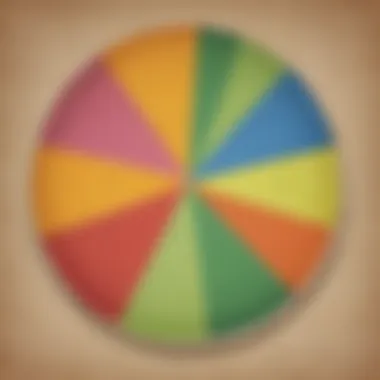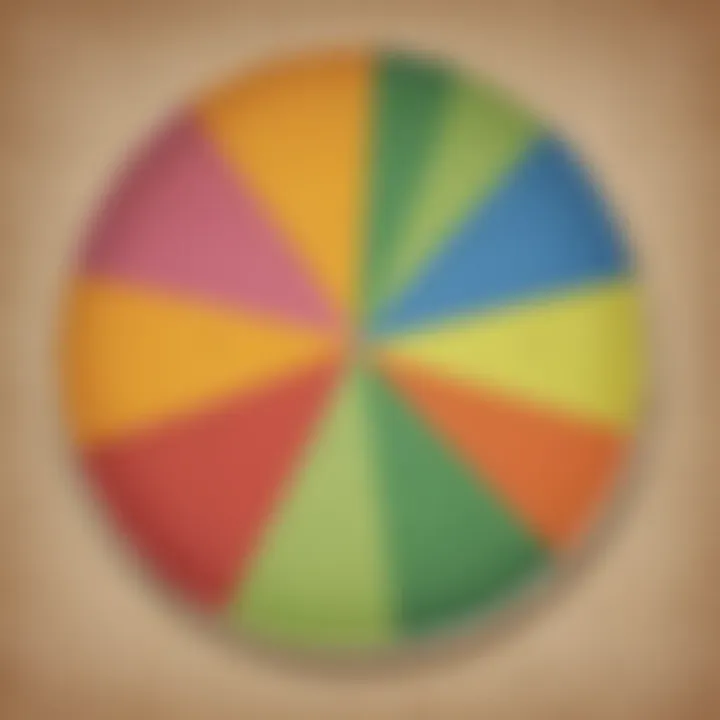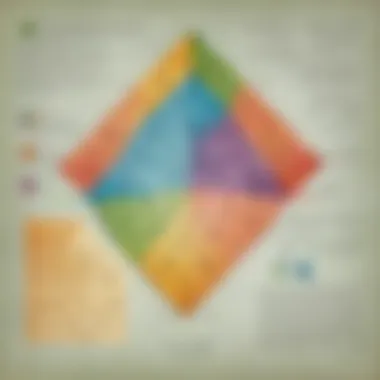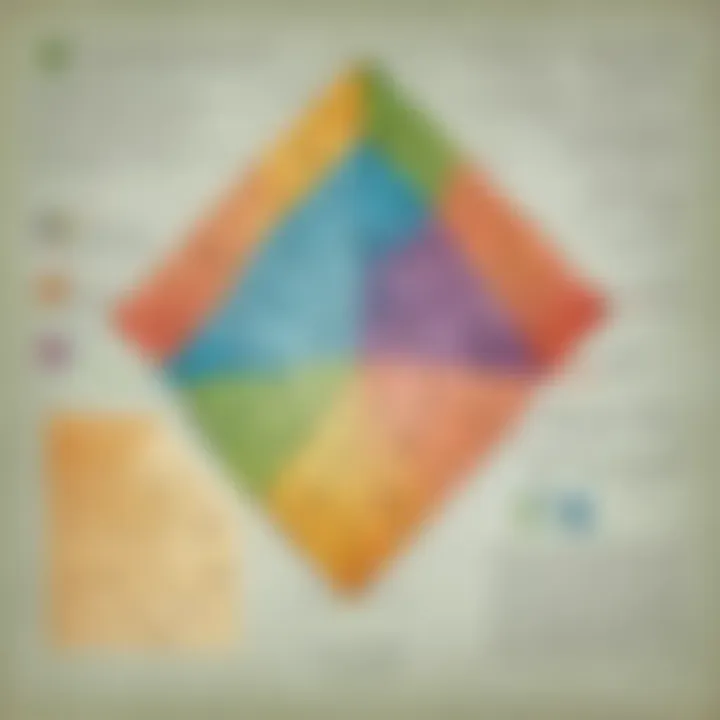Essential Guide to Understanding Fractions in Math


Intro
Fractions occupy a vital space in the realm of mathematics. They help illustrate how parts relate to a whole, a concept that extends beyond the confines of a classroom. The objective of understanding fractions is not merely to pass a grade but to gain skills applicable in everyday life—from measuring ingredients in a recipe to managing finances. This article will explore the building blocks of fractions, specifically targeting elementary students, parents, and educators. Expect to encounter topics ranging from basic definitions to practical activities that can brighten up any lesson on fractions.
Creative Activities
When it comes to learning, hands-on experience often beats rote memorization. Creative activities take theoretical knowledge and make it tangible.
Craft Ideas
Engaging children through crafts allows them to visualize concepts while having fun. Here are some simple craft ideas:
- Fraction Pizzas: Use paper plates and have children cut them into various fractions to assemble 'pizzas' topped with their favorite ingredients.
- Fraction Wall: Create a fraction wall with colored paper strips where each strip represents a different fraction.
- Fraction Art: Use watercolors to paint different shapes divided into fractions, introducing them to concepts like halves, quarters, and eighths.
Step-by-Step Guides
To efficiently carry out these activities, it’s essential to have clear instructions. For example, let’s take "Fraction Pizzas":
- Gather your materials: paper plates, scissors, and colored pencils.
- Draw your favorite toppings on the plate.
- Cut the plate into specified fraction parts (e.g., half, quarter).
- Assemble your pizza and share it with friends for a delicious display of math!
- Discuss the fractions represented in your pizza.
Educational Value
Through these activities, children develop fine motor skills, enhance their understanding of fractions, and gain the ability to communicate their findings. They also foster teamwork and creativity, making learning a shared experience.
Fun Quizzes
A key aspect of mastering fractions lies in reinforcement through practice. Fun quizzes can motivate and evaluate students' understanding of fractions.
Quiz Topics
Quizzes can cover a wide array of topics, including:
- Identifying proper and improper fractions.
- Simplifying fractions.
- Adding and subtracting fractions with the same or different denominators.
Question Types
In structuring these quizzes, various question types can engage students. For instance:
- Multiple Choice: Helps in making quick assessments.
- True/False Statements: Develops reasoning skills.
- Fill in the Blanks: Encourages recall.
Knowledge Reinforcement
Through ongoing quizzes, students can identify areas where they might be struggling. Engaging formats make numbers less daunting, turning learning into a game rather than a chore. Quizzes not only assess understanding but also illustrate how far students have come in their learning journey.
Fact-Based Articles
Reading articles that delve into fractions can broaden knowledge and comprehension.
Topics
Topics might cover everything from the history of fractions to advanced applications in various fields:
- The evolution of fractions over centuries.
- Real-world applications in cooking, construction, and beyond.
Engaging Content
Articles should present content in a digestible format, often supported by illustrations and practical examples, allowing readers to connect theories to applicable situations.
The Basics of Fractions
When discussing mathematical concepts, fractions often seem to be the unsung heroes intertwined throughout daily calculations. Understanding fractions is crucial because they are foundational in many areas of mathematics, serving as a bridge to more complex ideas. Whether it is dividing a pie or measuring ingredients, the significance of grasping fractions can't be overstated. They are not just numbers but indicators of relationships between quantities.
Defining Fractions
In simplest terms, a fraction represents a part of a whole. Think of it as a way of expressing division within whole numbers. It is inherently composed of two key elements: the numerator and the denominator.
- The numerator is the top part of the fraction, indicating how many parts we have.
- The denominator, on the bottom, shows into how many equal parts the whole is divided.
For instance, in the fraction 3/4, the 3 is the numerator and indicates that we have three parts, while the 4 as the denominator tells us there are four equal parts in total. By introducing pupils to this clear and direct definition, they begin to appreciate the concept of fractions as a means of sharing and distributing things evenly.
Numerators and Denominators


Delving deeper into fractions, numerators and denominators hold specific importance. This duo offers a rich basis for understanding various operations involving fractions. The numerator not only indicates the number of parts present but can also play a role in comparisons between fractions.
Meanwhile, denominators provide context and help in understanding how fractions relate to one another or to whole numbers. It’s also where confusion can often arise. A common misconception is equating fractions solely based on their numerators without considering their denominators. For example, 1/2 and 2/3 seem to have similar numerators but are quite different in value once you acknowledge their respective denominators. Understanding this relationship sets the stage for performing mathematical operations with fractions.
Types of Fractions
Learning about the types of fractions is essential, as it enriches the comprehension of the concept overall. Each type serves a different purpose and can be applied in various scenarios. The three primary types include:
Proper Fractions
A proper fraction is one where the numerator is smaller than the denominator. This characteristic means that proper fractions represent a quantity less than one. For instance, 2/5 shows that two parts out of a total of five parts are being considered. The simplicity and clarity of proper fractions make them incredibly useful for beginning learners, as they find it easier to visualize quantities that are less than one whole.
Improper Fractions
Contraving proper fractions, we have improper fractions where the numerator exceeds or is equal to the denominator. For instance, 5/3 indicates five parts of a total of three and represents a quantity greater than one. Improper fractions can be particularly useful in advanced mathematics like algebra and can represent whole numbers plus fractions.
One unique feature of improper fractions is that they can often be simplified. Understanding the concept of improper fractions sets the foundation for also grasping mixed numbers easily as students progress.
Mixed Numbers
Mixed numbers combine a whole number with a fraction, like in the case of 1 1/2 which depicts one whole and an additional half. This format can sometimes offer a more tangible understanding of fractions, especially in real-world applications such as cooking or measuring. They are particularly preferred for practical engagements since they express both whole and fractional values simultaneously, making them relatable.
Understanding these various types is instrumental for kids as they move forward in their mathematical journey. With a clear grasp of proper fractions, improper fractions, and mixed numbers, students lay the groundwork necessary for operations involving fractions, enabling them to tackle problems more confidently and intuitively.
Applications of Fractions
Fractions are not just numbers used to confuse students in a classroom. They are deeply embedded in our daily lives in various forms and functions. Understanding how fractions apply in real-world scenarios is key to grasping their significance. This section explores the practical applications of fractions, exhibiting how they are utilized across cooking, measurements, and daily tasks, ultimately showcasing their relevance.
Fractions in Cooking
One of the most common places you will see fractions pop up is in cooking. Recipes are designed with specific measurements, and many times, these are expressed in fractions. Imagine making a cake that requires one and a half cups of flour. If you don't know how to handle that half, you might end up with a batter that flops instead of rises. Understanding fractions allows cooks to scale recipes up or down, ensuring that they maintain the right balance of ingredients.
For instance, if you have a recipe meant for four servings but you need to feed eight, you’ll double each fraction in the recipe. Here’s how you can break it down:
- Original recipe: 1/2 cup sugar
- For 8 servings: 1/2 x 2 = 1 cup sugar
This practical approach not only maintains the taste but also ensures consistency in texture and flavor. In cases where a recipe calls for an unusual measurement, like 3/4 cup, this familiarity with fractions prepares individuals to tackle these kitchen challenges effectively.
Fractions in Measurements
Another significant aspect of fractions is their role in measurements. Whether dealing with lengths, weights, or volumes, fractions come into play in numerous forms. When measuring ingredients for construction or usage in crafts, precision is key, and fractions help achieve that accuracy.
For example, carpenters often need to work with specific dimensions. If a board measures 5 1/4 feet in length, they must know how to interpret that fraction effectively to cut it correctly. A simple misunderstanding can lead to disastrous results, such as cutting too short or too long. Here’s a practical point:
- A board measured at 5 1/4 feet means it’s 5 feet plus a quarter of a foot. Knowing that quarter is 12 inches divided by 4 helps the carpenter visualize and measure appropriately.
By relating fractions to concrete scenarios, students can see how critical they are when dealing with sizes, distances, and quantities.
Fractions in Everyday Life
Fractions seep into everyday life in ways often overlooked. From analyzing data to calculating budgets, understanding fractions enables individuals to make informed decisions. Consider someone who is managing a monthly budget. If the budget shows that 1/3 of it is allocated to groceries, 1/4 for savings, and 1/2 for rent, one must sum these fractions to grasp total expenditure.
- Multiplying fractions when calculating discounts is another common use. If a store offers a 25% discount on a product and then there’s an extra 10% off, the calculations involve understanding how to work out these fractions accurately. For instance:
- 25% can be represented as 1/4 and 10% as 1/10.
- Knowing how to apply these fractions helps you figure out pricing, ensuring you never overspend.
The necessity of understanding fractions permeates through various activities much like breathing; it’s there but often goes unnoticed until one stumbles upon a need to grasp it. Thus, exploring the applications of fractions not only solidifies their importance but also opens new pathways for learning and progression in one's understanding of mathematics.
Working with Fractions
Fractions are not just a standalone topic; they are vital in building foundational skills in mathematics and essential for more advanced concepts later on. Working with fractions involves a series of operations that allows individuals to understand their behavior and interplay in various contexts. This section aims to provide a detailed view of adding, subtracting, multiplying, and dividing fractions, highlighting their importance in the overall study of mathematics. Furthermore, mastering these operations fosters a deeper analytical ability when faced with real-world scenarios.
Adding Fractions
Same Denominator
Adding fractions with the same denominator is like adding apples to apples without having to worry about how many oranges you also have. When the denominators match, you simply focus on the numerators. This straightforward approach allows students to feel more comfortable and build confidence in dealing with fractions.
In this case, the fraction addition becomes effortless. You only need to sum the numerators while keeping the denominator unchanged. For example, if you are adding 1/4 and 2/4, your new fraction will be 3/4. The beauty of this method is that it minimizes error by reducing the steps in the calculation.
However, one should note that this approach is limited to fractions with matching denominators. Students might find it beneficial but could also face challenges later when confronted with more complex fractions.
Different Denominators


Adding fractions with different denominators introduces a twist to the process, turning it into a more intricate puzzle. To tackle this, you first need to find a common denominator, ideally the least common multiple of both denominators. This component strengthens a learner's problem-solving skills as they learn to convert the fractions first.
When you have, say, 1/3 and 1/6, you'll convert them to a common denominator of 6, making it easier to add them together. This results in a total of 3/6 + 1/6 = 4/6, which can be simplified to 2/3. While this process can be challenging, it significantly broadens a student's conceptual understanding of fractions and enhances their ability to manage more complicated equations.
Subtracting Fractions
Same Denominator
Subtraction of fractions with the same denominator is similar to the addition process. The basics apply here; you merely subtract the numerators and retain the common denominator, akin to taking away some apples from a basket. If you have 3/5 and you subtract 1/5, the result is simply 2/5, a quick and clean subtraction without getting tangled in complexities.
This straightforward characteristic of subtracting like fractions is important because it reinforces the concept of parts versus wholes without overwhelming young learners. However, over-reliance on this simplicity may lead to difficulties when students have to subtract fractions with differing denominators.
Different Denominators
When it comes to subtracting fractions with different denominators, the process resembles a mini math adventure. Similar to addition, you first need to find a common denominator. Let’s take 2/5 and 1/10 as an example. You must convert these fractions to a common base of 10, leading to 4/10 and 1/10. Once you have a matching denominator, the subtraction is a breeze, resulting in 3/10.
This method encourages students to think critically about how fractions interact and develop their understanding of equivalencies, which can be beneficial in both everyday calculations and more formal math contexts.
Multiplying Fractions
Multiplying fractions is often considered simpler than adding or subtracting. To multiply two fractions, you simply multiply the numerators together and the denominators together. For instance, if you multiply 2/3 by 3/4, you end up with 6/12. The process of simplification, reducing the fraction to 1/2, is also an essential skill. It helps learners see that multiplication is about scaling fractions rather than modifying their forms. This operation holds immense value in scenarios like calculating areas or scaling recipes where precise measurements are needed.
Dividing Fractions
Dividing fractions, while sometimes seen as daunting, really just requires a little twist. Instead of a traditional divide, you turn the second fraction (the divisor) upside down and multiply. For example, if you need to divide 1/2 by 1/3, you flip 1/3 to get 3/1 and then multiply: 1/2 * 3/1 = 3/2. This unique approach cultivates flexibility in thinking, turning a problematic division into a multiplication operation. Such skills can come handy in various contexts including fractions in financial literacy or when adjusting recipes.
Working with fractions lays the groundwork for a better understanding of numerical relationships, whether simple or complex. The mechanics of adding, subtracting, multiplying, and dividing fractions prepare students for greater challenges in mathematics, offering them the tools needed for problem-solving in real life. The journey through fractions is not just about numbers; it's about understanding the world through the lens of mathematics.
Visualizing Fractions
Visualizing fractions is critical for grasping this fundamental concept in mathematics. It allows learners, particularly elementary school students, to see how fractions represent parts of a whole. Through visual aids, students can better understand concepts such as proportionality and relationships between different fractions. This not only boosts their mathematical skills but also enhances their ability to think critically and solve problems.
Using Number Lines
A number line serves as a practical way to illustrate fractions. A simple horizontal line marked with equal divisions can effectively demonstrate how fractions fit within the whole numbers. For instance, if you draw a number line from 0 to 1, and mark it with divisions, you could show where 1/2 and 1/4 sit relatively.
By placing fractions on a number line, children can visually comprehend their values and relationships—for example, understanding that 1/4 is less than 1/2 and greater than 0. This approach reinforces their knowledge of fractions as they interact with and manipulate these visual representations.
Fraction Circles
Fraction circles present another excellent method for visualizing fractions. These circles can be divided into various sections to depict different fractions. For example, a circle can be split into two halves, three equal parts, or four quarters. When students color or shade in these sections, they can tangibly see how three out of four pieces (3/4) fill more of the circle compared to one out of two (1/2).
Using fraction circles aids in developing a stronger concept of equivalency. When students can visualize that 2/4 is the same as 1/2, and see it on the circle, it solidifies their understanding. It’s a hands-on learning experience that makes fractions less intimidating and more relatable.
Area Models
Area models offer yet another visualization tool to students. They work by utilizing rectangles to represent fractions. Imagine a rectangle that represents a whole, split into different equal parts. If you have a rectangle with a length of 4 units and you've shaded 1 out of 4 equal sections, you visually demonstrate 1/4 of the area.
Such models allow for clear geometric interpretations of fractions. This is especially useful in understanding operations like addition and subtraction, where students can combine or separate shaded areas to see fractional parts practically. For example, if you need to add 1/2 and 1/4, you can represent both on the area model and visually see how they combine.
"Visual aids in fractions help solidify understanding and transform abstract concepts into tangible learning experiences."
By integrating number lines, fraction circles, and area models into lessons, educators create a rich learning environment that adapts to different learning styles. This not only aids comprehension but prepares students for more advanced mathematical concepts by laying a solid groundwork in fractions.
Common Misconceptions Around Fractions
Understanding fractions, their structure, and their behavior isn’t as straightforward as one might think. There are multiple misconceptions that can cloud a person’s understanding, especially for young learners. Clearing these misconceptions serves as the foundation for grasping more complex mathematical concepts later on. Misunderstanding fractions can lead to confusion, making math feel like a mountain too steep to climb. In this section, we’re diving into specific misconceptions that often trip up students and how to clarify these misunderstandings.
Misunderstanding Denominators
One of the most common troubles students face with fractions is related to denominators. The denominator, the number below the line, tells us how many equal parts a whole is divided into. Here’s where things can get muddy. Sometimes, students think that a larger denominator always means a larger fraction.
For example:
- 1/2 is larger than 1/4, but students might erroneously think that since 4 is larger than 2, 1/4 should be bigger.
To counter this, a practical way to show this is to use visual aids. Drawing pizza slices, for instance, can be very illustrative. If you have one pizza cut into two big slices and another pizza cut into four smaller slices, which one would satisfy a hungry group first? Yes, the larger slices! That’s because while you have more pieces in the second pizza, each piece is smaller. This visual representation helps shine a light on proportion rather than just focusing on numbers.
Moreover, the concept of equal parts can also come into play. When students encounter a fraction like 3/4, they need to understand that this means three out of four equal pieces, not simply focusing on numbers without context. Clarification of the role of the denominator is crucial for students to be confident in their understanding of relationships between fractions.
Confusing Mixed Numbers and Improper Fractions
Another stumbling block comes with mixed numbers and improper fractions. A mixed number, like 2 1/3, combines a whole number with a fraction. On the other hand, an improper fraction, such as 7/4, has a numerator larger than the denominator. Students often struggle with the distinction and often misidentify these fractions bravely, believing they are interchangeable when they are not.


Here's how to make this clearer:
- Visual aids: Show students both types of fractions using objects like toy blocks or a pizza again.
- Convert skills: Teach students how to change mixed numbers into improper fractions and vice versa. For example, 2 1/3 can be converted by multiplying the whole number by the denominator (2 × 3 = 6) and then adding the numerator (6 + 1 = 7), giving 7/3.
- Real-life examples: Utilizing scenarios such as pie slices at a party could also help students relate these concepts to real-life situations. If two whole pies and a third of another pie are on the table, you can show that it’s the same as two and a third pies.
Addressing these misconceptions not only enhances a student's understanding of fractions, it empowers them to feel more competent in handling mathematical challenges.
"Understanding is the first step to mastery; misconceptions often confuse the pathway."
Encouraging curiosity and questioning can help demystify these topics, making math less of a chore and more of an exploration. Using engaging resources can further cement these concepts, allowing children to view fractions in a more relatable and less intimidating manner.
Practical Exercises for Mastery
Practical exercises play a significant role in solidifying a child's grasp of fractions. Engaging in hands-on activities allows learners to understand fractions beyond theoretical definitions. Many students might memorize rules without truly comprehending them, which can lead to confusion later on. Thus, practical exercises are not just beneficial; they are essential. They provide immediate feedback, reinforce classroom learning, and encourage problem-solving skills, making them a cornerstone of effective education.
"Practice makes perfect" is not just a catchy phrase; it's a truth that applies especially to fractions.
Through exercises, children can see fractions in action, understand their relevance, and improve their ability to perform various operations with them, forming a strong base for more advanced math concepts down the road.
Simple Addition and Subtraction
When it comes to mastering fractions, addition and subtraction are some of the first operations that children encounter. It can be tricky for them to grasp how to add or subtract different fractions. This is due to the need for a common denominator. Engaging in simple exercises ensures that children can practice getting that denominator before going on to more complex problems.
- Example 1: If a student has
- Example 2: If they try 1/4 + 1/3, they may face a challenge. It’s vital they learn to find a common denominator—12 in this case. So, they would convert it:
- 1/4 + 1/4 = 2/4 (simplifies to 1/2).
- 1/4 = 3/12 and 1/3 = 4/12
- Thus, 3/12 + 4/12 = 7/12.
Through these steps, kids will get a feel for not only adding fractions but also the important concept of finding a common ground (a shared denominator). Practicing these simple addition and subtraction problems enhances their confidence when these operations surface in more complicated scenarios.
Multiplication and Division Challenges
Next, we dive into multiplication and division of fractions, which often come with their own set of struggles. The beauty of fraction multiplication is that it's somewhat simpler than addition or subtraction. By taking a fraction and multiplying it by another, a child essentially multiplies the numerators and denominators separately. However, students need practice to grasp the concept effectively.
- Multiplication Example: 1/2 * 3/4 = (1 * 3)/(2 * 4) = 3/8.
For division, children might find it somewhat more confusing because it involves flipping a fraction (finding the reciprocal). This can be hard to remember and it’s a unique step compared to what they previously learned.
- Division Example: To divide 1/3 by 1/6, they need to multiply by the reciprocal of the second fraction. Thus, 1/3 ÷ 1/6 translates to 1/3 * 6/1 = 6/3 = 2.
Incorporating various challenges will help children feel more comfortable with fractions and increase their problem-solving capabilities.
Real-Life Application Problems
Fractions won't simply show up on a test; they are everywhere in real life. To truly master the concept, students should tackle problems grounded in everyday situations. This not only shows the practical uses of fractions but also makes the material relatable and easier to grasp. A few scenarios might include:
- Cooking or Baking: Recipes often call for fractions, helping children understand how to use them in portions or quantities. If a recipe requires 2/3 cup of sugar and they want to double it, they would need to figure out how much sugar to use— 4/3 or 1 and 1/3 cups.
- Shopping Discounts: If something costs $30 and you get a 1/4 discount, that’s a real-life application needing fraction calculations to find the final price.
- Sharing Food: When dividing pizza, asking a child how many slices each person gets can incorporate fractions naturally into their experience.
By creating relatable stories where fractions play a pivotal role, it makes the lessons memorable and far more engaging. The real-life application of fractions ties together the concepts discussed, showcasing how understanding fractions can be both useful and necessary.
Resources for Further Learning
Understanding fractions is a journey, and like any road trip, having the right maps and tools makes all the difference. That's where strong resources come into play. When kids grasp the concept of fractions, it opens doors to better math skills and real-world applications. The resources highlighted below can assist both students and parents in enhancing their knowledge and understanding of fractions.
Books on Fractions
Books stand as timeless guides in learning. When it comes to fractions, there are several titles worth considering:
- "Fraction Fun" by David Adler: This book, aimed at younger readers, paints a clear picture of fractions with colorful illustrations and engaging examples. It's a fun way for children to get comfortable with the idea.
- "Understanding Fractions" by Linda D. Williams: This book provides a detailed yet comprehensive look into fractions, making complex ideas more digestible for kids.
- "Fraction Action" by Loreen Leedy: With its lively illustrations, this book introduces fractions through everyday situations, helping children see the relevance in real life.
These books not only explain fractions but also encourage kids to think critically about the concept, making learning both enjoyable and impactful.
Online Fraction Games
Games make learning engaging. There are numerous online platforms where students can practice their fraction skills in a fun environment. Here are a few notable ones:
- Cool Math Games: This site hosts a variety of interactive games focused on fractions, suitable for all levels. Kids learn while they play, paving the way for better retention.
- PBS Kids Math Games: With educational games tied to popular children’s shows, this resource creates a familiar context for learning fractions, making it less intimidating.
- Khan Academy: Known for its varied resources, Khan Academy features exercises and quick quizzes that challenge kids with different fraction concepts.
These online games provide not just practice but also a healthy dose of enjoyment, helping kids to gain confidence in their fraction skills.
Educational Videos and Tutorials
Visual learning is a key component to effective education. Video content can clarify tricky topics like fractions. Below are some reliable platforms:
- YouTube Educational Channels - Learn Zillion: This YouTube channel offers a series of videos specifically targeting fractions, breaking them down into smaller, manageable parts.
- Khan Academy Videos: The videos available here are step-by-step guides that make fractions easier to comprehend. Students can watch at their own pace, rewinding when necessary.
- National Geographic Kids: Known for its engaging content, this resource provides fun fractions-related videos that connect math concepts to the real world.
These tutorials are valuable tools for visual learners, reinforcing concepts through demonstrations and models.
"The right resources can turn a challenging topic into one that feels approachable and even enjoyable."







